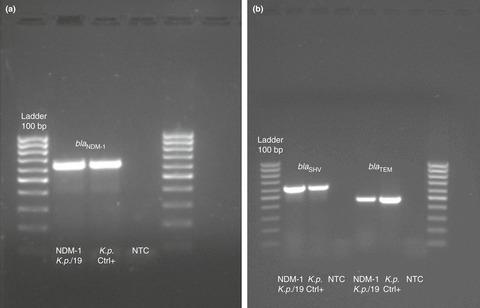当前位置:
X-MOL 学术
›
Lett. Appl. Microbiol.
›
论文详情
Our official English website, www.x-mol.net, welcomes your
feedback! (Note: you will need to create a separate account there.)
New Delhi metallo-β-lactamase (NDM-1)-producing Klebsiella pneumoniae of sequence type ST11: first identification in a hospital of central Italy
Letters in Applied Microbiology ( IF 2.0 ) Pub Date : 2020-09-22 , DOI: 10.1111/lam.13384 G Ripabelli 1 , M L Sammarco 1 , A Salzo 1 , M Scutellà 2 , V Felice 2 , M Tamburro 1
Letters in Applied Microbiology ( IF 2.0 ) Pub Date : 2020-09-22 , DOI: 10.1111/lam.13384 G Ripabelli 1 , M L Sammarco 1 , A Salzo 1 , M Scutellà 2 , V Felice 2 , M Tamburro 1
Affiliation

|
The emergence of novel resistant markers hampers the efficacy of beta‐lactam antibiotics to treat infections caused by micro‐organisms carrying such resistances. This study investigated the antimicrobial susceptibility pattern, the carpapenem‐associated determinants and the molecular epidemiology of Klebsiella pneumoniae showing a New Delhi (NDM) metallo‐β‐lactamase phenotype, isolated from a patient admitted to intensive care unit of the main hospital for acute care of Molise region, central Italy. Antimicrobial susceptibility was assessed for nineteen antibiotics by disc diffusion and agar dilution methods. Carbapenem‐associated resistance determinants were detected through gene‐specific amplifications, targeting blaNDM‐1, blaSHV and blaTEM, blaCTX‐M, blaKPC, blaVIM, blaIMP, blaGES and blaOXA‐48‐lixe. Molecular characterization was carried out through multilocus sequence typing. The strain showed a multidrug resistant profile, and PCR and sequencing confirmed the presence of blaNDM‐1 gene. Among the multiple resistance‐associated determinants tested, the isolate, which was assigned to the sequence type ST11, only harboured blaSHV and blaTEM genes. This is the first report of NDM‐1 variant in the regional healthcare setting for acute patients, raising significant concerns about the increase in the antimicrobials resistance spread through a different mechanism from the endemic KPC carbapenemase, and underlining the circulation of a virulent clone never identified before in this area.
中文翻译:

产新德里金属β-内酰胺酶(NDM-1)的ST11型肺炎克雷伯菌:在意大利中部一家医院首次鉴定
新型抗性标记物的出现阻碍了 β-内酰胺抗生素治疗由携带此类抗性的微生物引起的感染的功效。本研究调查了肺炎克雷伯菌的抗生素敏感性模式、卡青霉烯相关决定因素和分子流行病学,显示新德里 (NDM) 金属-β-内酰胺酶表型,从一名住进重症监护病房的主要医院重症监护病房的患者中分离出来。意大利中部莫利塞地区。通过圆盘扩散和琼脂稀释方法评估了 19 种抗生素的抗生素敏感性。通过基因特异性扩增检测碳青霉烯相关耐药性决定因素,靶向 blaNDM-1、blaSHV 和 blaTEM、blaCTX-M、blaKPC、blaVIM、blaIMP、blaGES 和 blaOXA-48-lixe。通过多位点序列分型进行分子表征。该菌株表现出多重耐药性,PCR 和测序证实了 blaNDM-1 基因的存在。在测试的多个抗性相关决定因素中,分配给序列类型 ST11 的分离株仅含有 blaSHV 和 blaTEM 基因。这是针对急性患者的区域医疗保健环境中 NDM-1 变异的第一份报告,引起了人们对通过与地方性 KPC 碳青霉烯酶不同的机制传播的抗菌素耐药性增加的严重担忧,并强调了从未发现的毒力克隆的循环之前在这个区域。在测试的多个抗性相关决定因素中,分配给序列类型 ST11 的分离株仅含有 blaSHV 和 blaTEM 基因。这是针对急性患者的区域医疗保健环境中 NDM-1 变异的第一份报告,引起了人们对通过与地方性 KPC 碳青霉烯酶不同的机制传播的抗菌素耐药性增加的严重担忧,并强调了从未发现的毒力克隆的循环之前在这个区域。在测试的多个抗性相关决定因素中,分配给序列类型 ST11 的分离株仅含有 blaSHV 和 blaTEM 基因。这是针对急性患者的区域医疗保健环境中 NDM-1 变异的第一份报告,引起了人们对通过与地方性 KPC 碳青霉烯酶不同的机制传播的抗菌素耐药性增加的严重担忧,并强调了从未发现的毒力克隆的循环之前在这个区域。
更新日期:2020-09-22
中文翻译:

产新德里金属β-内酰胺酶(NDM-1)的ST11型肺炎克雷伯菌:在意大利中部一家医院首次鉴定
新型抗性标记物的出现阻碍了 β-内酰胺抗生素治疗由携带此类抗性的微生物引起的感染的功效。本研究调查了肺炎克雷伯菌的抗生素敏感性模式、卡青霉烯相关决定因素和分子流行病学,显示新德里 (NDM) 金属-β-内酰胺酶表型,从一名住进重症监护病房的主要医院重症监护病房的患者中分离出来。意大利中部莫利塞地区。通过圆盘扩散和琼脂稀释方法评估了 19 种抗生素的抗生素敏感性。通过基因特异性扩增检测碳青霉烯相关耐药性决定因素,靶向 blaNDM-1、blaSHV 和 blaTEM、blaCTX-M、blaKPC、blaVIM、blaIMP、blaGES 和 blaOXA-48-lixe。通过多位点序列分型进行分子表征。该菌株表现出多重耐药性,PCR 和测序证实了 blaNDM-1 基因的存在。在测试的多个抗性相关决定因素中,分配给序列类型 ST11 的分离株仅含有 blaSHV 和 blaTEM 基因。这是针对急性患者的区域医疗保健环境中 NDM-1 变异的第一份报告,引起了人们对通过与地方性 KPC 碳青霉烯酶不同的机制传播的抗菌素耐药性增加的严重担忧,并强调了从未发现的毒力克隆的循环之前在这个区域。在测试的多个抗性相关决定因素中,分配给序列类型 ST11 的分离株仅含有 blaSHV 和 blaTEM 基因。这是针对急性患者的区域医疗保健环境中 NDM-1 变异的第一份报告,引起了人们对通过与地方性 KPC 碳青霉烯酶不同的机制传播的抗菌素耐药性增加的严重担忧,并强调了从未发现的毒力克隆的循环之前在这个区域。在测试的多个抗性相关决定因素中,分配给序列类型 ST11 的分离株仅含有 blaSHV 和 blaTEM 基因。这是针对急性患者的区域医疗保健环境中 NDM-1 变异的第一份报告,引起了人们对通过与地方性 KPC 碳青霉烯酶不同的机制传播的抗菌素耐药性增加的严重担忧,并强调了从未发现的毒力克隆的循环之前在这个区域。











































 京公网安备 11010802027423号
京公网安备 11010802027423号